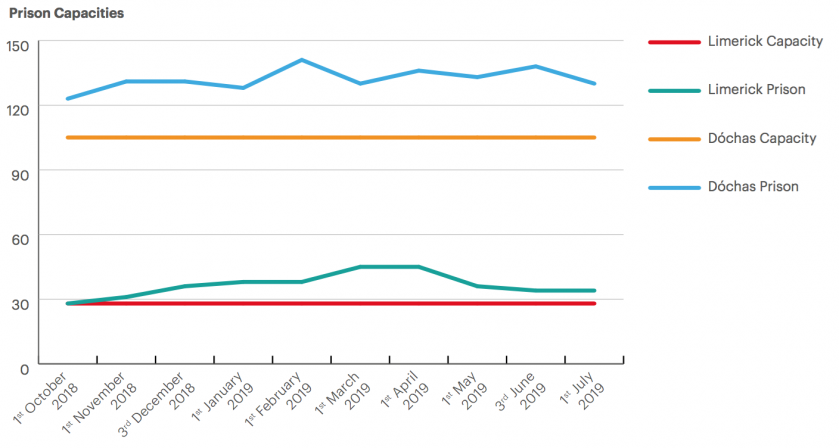Current context:
In 2019, the Chairperson of the IOG of the Penal Policy Review raised specific concerns about the implementation of recommendations made for women:
I might note, in particular, Recommendation 21, which advocates that: “gender appropriate strategies are adopted to the management of female offending and female offenders”. [..] it remains the case that the number of women entering prison raises serious questions about whether the Penal Policy Review Group’s envisaged approach concerning women in the criminal justice system is being fulfilled.[539]
Approximately 38% of women in prison under sentence were serving sentences of less than 12 months in December 2018.[540] Two-fifths (39%) of female committals under sentence in 2018 were for theft and related offences.[541]
Overcrowding continues to be a consistent feature of the two women’s prisons, as illustrated below.[542]

An analysis of a four-month period (February to May 2019) shows that Limerick (female) Prison has the third highest incidence of mattress use, at six per day.[543]
One welcome development has been the opening of a new supported facility, the Outlook Women’s Programme, in April 2019, which provides accommodation and support services for women leaving prison.[544] The programme is run in partnership with the Probation Service, the IPS and homeless charity Focus Ireland.[545] The aim of the programme is to gradually reintegrate women into independent living in the community.[546]
Indicators for Standard:
Indicators for Standard 32.1
Indicator S32.1.1: Imprisonment as a last resort (female prison committal rates and daily imprisonment rates). (new)
Female committal rates and female daily prison population rates, 2016–2018[547]
| Year |
Female Committal Rates |
Female daily prison population rates |
|---|
| 2016 |
2,937 |
140 |
| 2017 |
1,344 |
144 |
| 2018 |
1,005 |
165 |
Female committal rates have significantly decreased by 65% since 2016. However, the daily female prison population has increased by 17.8% since 2016.
Indicator S32.1.2: Access to and availability of gender-specific community sanctions.
Further mapping is needed to determine the availability of gender-specific community sanctions across the country.
Women under a community service order, 2016–2018 (n.)
| Year |
Community service Orders[548] |
|---|
| 2017 |
215 |
| 2018 |
218 |
| 2019 |
291 |
Indicator S32.1.3: Publication of data and research on women in the criminal justice system.
There has been no publication of research on women in the criminal justice system.
Indicator S32.1.4: Establishment of a step-down facility/supported accommodation for women upon release.
A new facility, called the Outlook Women’s Programme, has been opened in Dublin.[549] It provides accommodation and supports for women leaving custody or on probation supervision in the community.
Analysis
Overall female committal rates have decreased substantially. This can be attributed to the commencement of the Fines (Payment and Recovery) Act 2014.[550] This shows that further change for women who offend is achievable.
However, the persistently high daily prison population figures suggest prison is not being used as a sanction of last resort: more than one-third of women are serving a sentence of less than 12 months.[551]
Community service orders increased for women in 2019. Further mapping needs to be done to identify the availability of gender-specific community sanctions throughout the country.
While IPRT welcomes the establishment of step-down facility for women leaving custody, there has been no progress on the establishment of an open prison for women serving long sentences, and women’s prison remain overcrowded on a continual basis.
Overall, more concerted action is urgently needed towards full implementation of the Joint Probation Service-Irish Prison Service Strategy 2014-2016 An Effective Response to Women Who Offend.[552] Publication of data and research on women in the criminal justice system is also vital in terms of identifying and addressing current gaps in provision.
Status of Standard 32: Mixed


